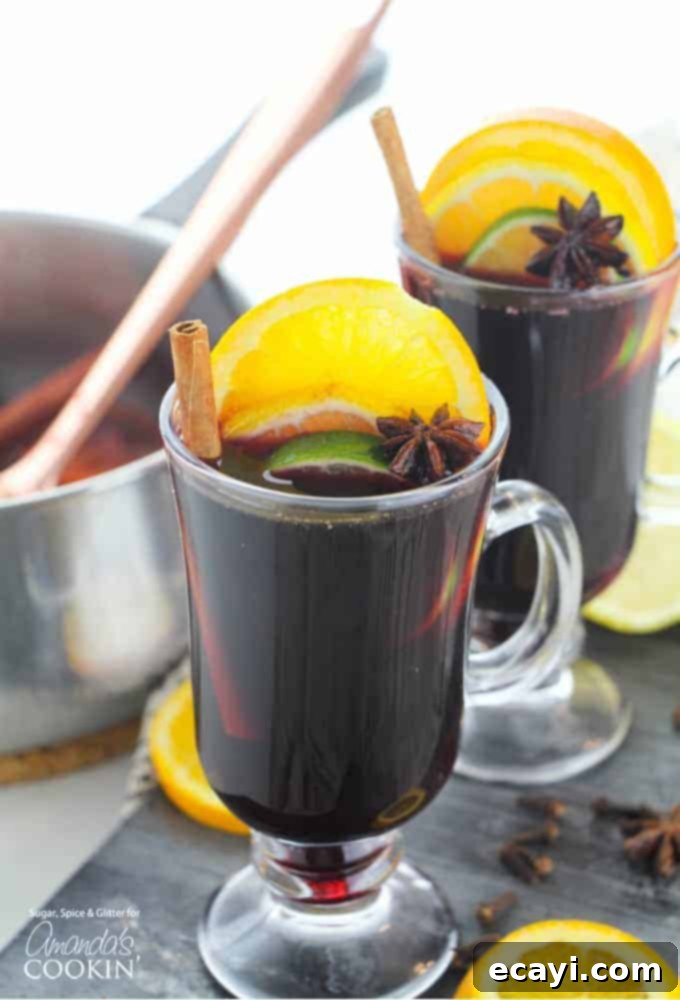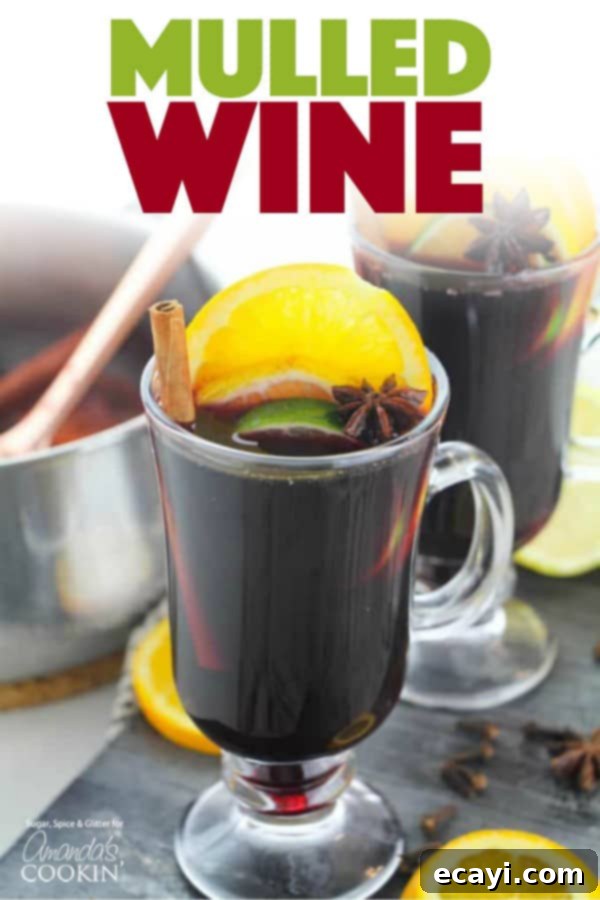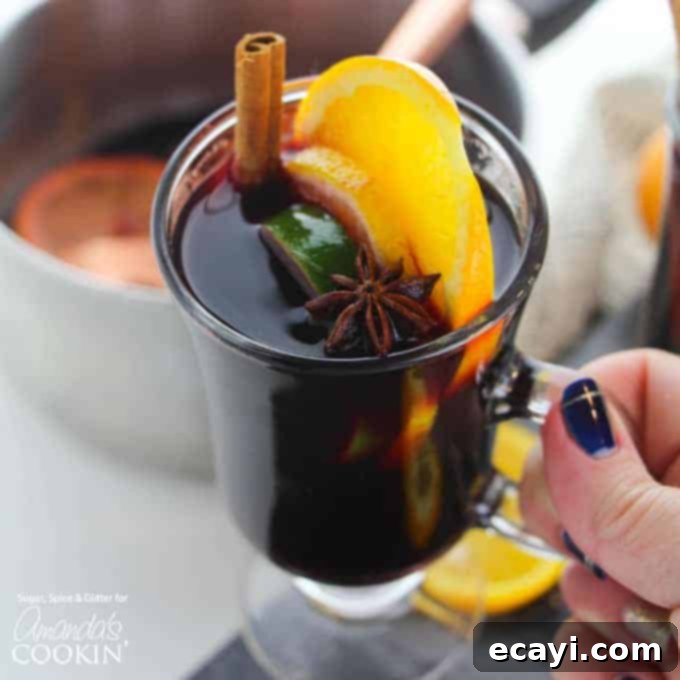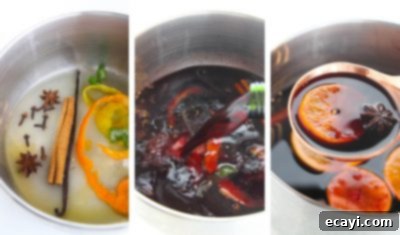Easy Classic Mulled Wine Recipe: Your Ultimate Guide to a Cozy Holiday Drink
This holiday season, transcend the ordinary and fill your home with an aroma that’s far more inviting than any candle. Our tried-and-true mulled wine recipe promises to be the perfect companion for chilly evenings, warming your hands and delighting your palate with its rich, spiced flavors. It’s not just a drink; it’s an experience, a fragrant journey that instantly transforms any gathering into a festive celebration.
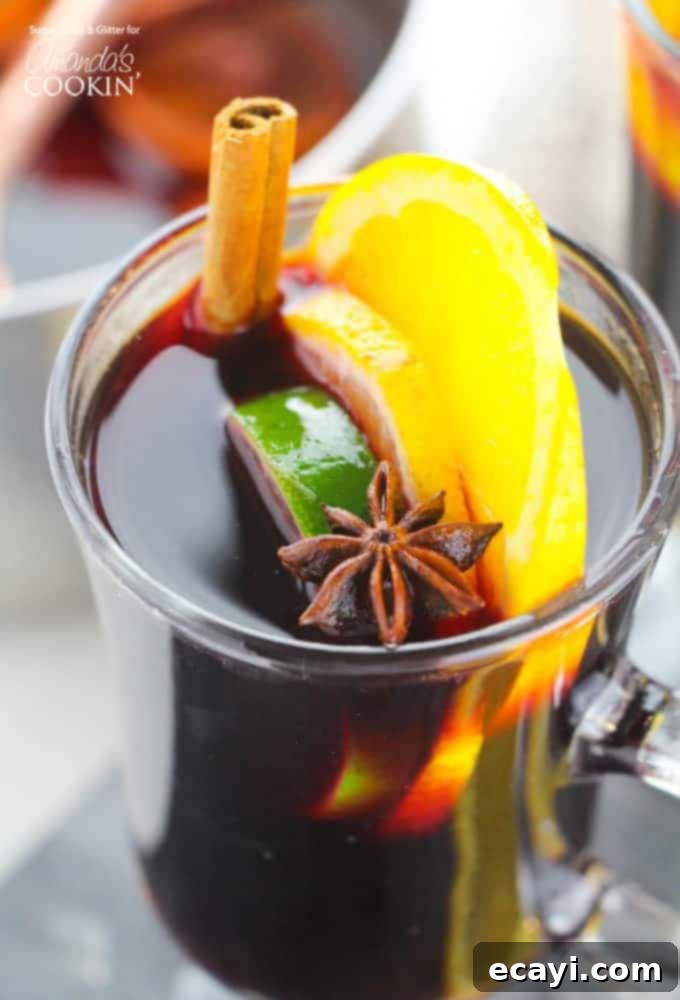
The Enduring Charm of Mulled Wine: A Historical Sip
Mulled wine, often synonymous with European Christmas markets and festive gatherings, boasts a history as rich and warming as its flavor. Its origins stretch back to ancient Roman times, where wine was not just consumed for pleasure but also for its perceived health benefits and as a means of preservation. The Romans were known for “conditum paradoxum,” a spiced wine made with honey, pepper, saffron, and dates, which was often heated and enjoyed as a fortifying drink.
As the Roman Empire expanded across Europe, so did the tradition of heating and spicing wine. In colder climates, particularly during harsh winters, warming wine became a practical way to make it more palatable and comforting. Spices, highly prized and often believed to possess medicinal properties, were added to promote health and ward off sickness, a common concern in the days before modern medicine. Additionally, sweeteners were frequently used to mask the often unpleasant taste of lower-quality or spoiled wines, which were far more prevalent than fine vintages.
Throughout the Middle Ages, spiced wines, sometimes referred to as “hippocras,” continued to be popular across Europe. They were often considered drinks of the wealthy due to the expense of the exotic spices. However, the tradition eventually waned in many regions, except for Scandinavia. Here, mulled wine persisted and evolved into “glogg,” a strong, often fortified, and intensely spiced version that remains a beloved part of Nordic holiday traditions.
Fortunately, this delightful beverage has enjoyed a significant resurgence in popularity in recent centuries, particularly with the revival of traditional Christmas markets across Europe and beyond. Today, a steaming mug of mulled wine is an iconic symbol of winter festivities, bringing people together with its comforting warmth and intoxicating aroma. It’s a simple pleasure that connects us to centuries of tradition and good cheer.
Crafting Your Perfect Mulled Wine: Tips for Success
While the basic concept of mulled wine is simple, a few considerations can elevate your homemade batch from good to unforgettable. I’ve kept this mulled wine recipe relatively traditional, but I always encourage you to make it your own. The beauty of mulled wine lies in its adaptability, allowing you to tailor it to your exact preferences.
Choosing the Right Wine Base
The foundation of any great mulled wine is, of course, the wine itself. It doesn’t need to be an expensive bottle, but a general rule of thumb applies: if you wouldn’t enjoy drinking it plain, it’s unlikely to magically transform into something delicious when mulled. Opt for a good-quality, dry, and fruit-forward red wine. Varieties like Merlot, Grenache, Zinfandel, or even a basic Cabernet Sauvignon work wonderfully. These wines provide a robust base that can stand up to the strong flavors of the spices without overpowering them. Avoid wines that are heavily oaked or have very strong tannins, as these characteristics can become amplified and sometimes bitter when heated, detracting from the overall balance. For this particular recipe, I found a $9 Portuguese red wine to be absolutely perfect, proving that affordability doesn’t mean sacrificing flavor or quality.
The Symphony of Spices and Citrus
The spices are where the magic truly happens, infusing the wine with those signature festive flavors that evoke holiday cheer. Traditional mulled wine often features spices similar to those found in a chai tea, creating a comforting and exotic profile. Our recipe includes essential whole cloves, fragrant cinnamon sticks, aromatic whole nutmeg, and the delicate sweetness of a vanilla pod, all working in harmony to create a complex and inviting aroma.
For an extra layer of visual appeal and bright, tangy notes, I love using a variety of citrus fruits. Beyond traditional oranges or clementines, adding a lemon and a lime introduces a vibrant depth of flavor that beautifully cuts through the richness of the wine and spices. These bright hues also add some much-needed color during dreary winter days, making your drink as pleasing to the eye as it is to the palate! While star anise is a traditional spice and visually stunning, I admit I’m not its biggest fan personally. This is a perfect example of how you can tailor the recipe: feel free to adjust the spice quantities or even omit certain ones to match your personal preferences. The ultimate goal is a flavor profile you truly love, so don’t hesitate to experiment with additions like ginger, cardamom, or even a splash of brandy for an extra kick.
Pairing Your Mulled Wine
Since the warm, comforting spices in mulled wine echo those often found in chai tea, a chai-inspired dessert makes an exceptionally good pairing. Consider serving it alongside our Chocolate Chai Poke Cake for a truly cohesive flavor experience that will impress your guests. Alternatively, classic holiday treats like gingerbread cookies, rich fruitcake, shortbread biscuits, or even a simple cheese board with seasonal fruits and nuts would also complement this winter cocktail beautifully. Its versatility makes it a fantastic accompaniment to both sweet and savory holiday fare.
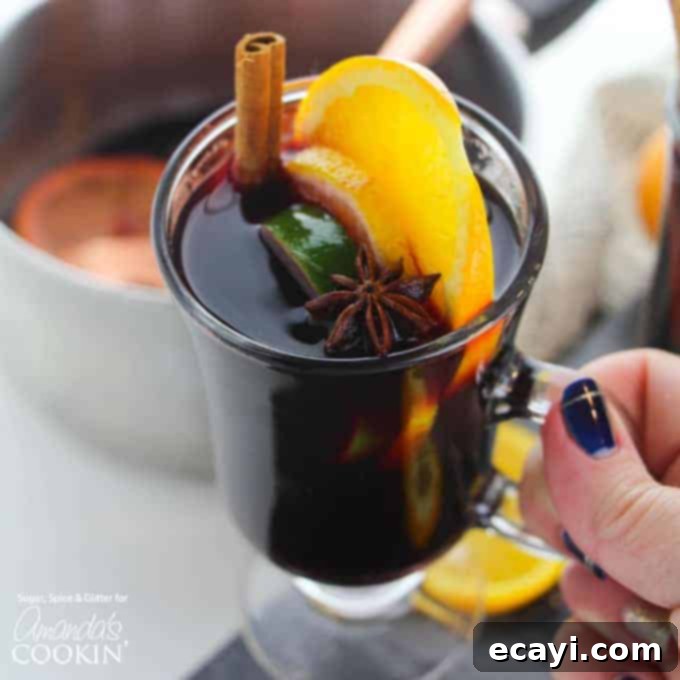
Ingredients for This Classic Mulled Wine Recipe
- 2 cups sugar, or to taste (adjust based on wine sweetness and personal preference)
- 2 oranges
- 2 clementines
- 1 lemon
- 1 lime
- 8 whole cloves
- 2 cinnamon sticks
- 1 whole nutmeg (or 1 tsp ground nutmeg, preferably in a spice bag)
- 1 vanilla pod, split lengthwise
- 2 star anise pods (optional, adjust to taste)
- 2 bottles red wine (approximately 50 oz / 1.5 liters)
Essential Kitchen Tools for Mulled Wine Success:
- Large Saucepan or Dutch Oven: Essential for simmering and infusing all those wonderful flavors. A heavy-bottomed pot will help prevent scorching.
- Measuring Cups and Spoons: For accurate ingredient quantities, though mulled wine is quite forgiving.
- Ladle: For easy and safe serving into mugs, especially when hot.
- Heat-Resistant Glass Mugs or Festive Goblets: To best enjoy your warm, aromatic beverage.
- Fine-Mesh Sieve (optional): For straining out spices and fruit if desired before serving, though many prefer to leave them in for aesthetic appeal and continued infusion.
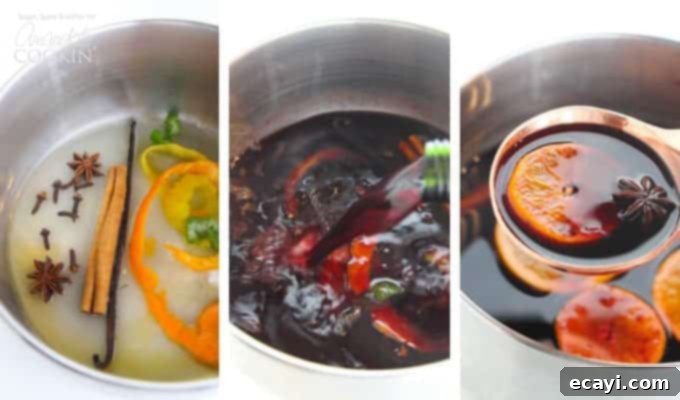
Simple Steps to Make Mulled Wine
Creating this aromatic holiday drink is surprisingly straightforward and incredibly rewarding. Follow these simple yet effective steps for a perfectly spiced and warming beverage that will be the highlight of your festive season:
-
Prepare Your Citrus and Vanilla: Begin by carefully peeling the rinds from your oranges, clementines, lemon, and lime. The goal is to get as little of the white pith as possible, as it can impart a bitter taste to your mulled wine. Once peeled, cut and juice the fruits, reserving both the colorful peels and the fresh juice. Take your vanilla pod and split it lengthwise down the center with a sharp knife to expose the fragrant, tiny seeds inside, which will release their essence more effectively.
-
Create the Spice Base: In a large saucepan or Dutch oven, combine the measured sugar, fresh citrus juices, citrus peels, the split vanilla pod, and all your chosen whole spices (whole cloves, cinnamon sticks, whole nutmeg, and star anise pods if using). Pour in just enough red wine to barely cover the sugar and spices – typically about 1 to 1.5 cups. This initial, smaller amount of wine will help create a concentrated syrup.
-
Simmer and Reduce for Flavor: Place the saucepan over medium heat. Bring the mixture to a gentle bubble, stirring occasionally to ensure the sugar fully dissolves. Once bubbling, reduce the heat slightly and allow the mixture to simmer for about 10-15 minutes, or until the liquid has visibly reduced by approximately half. This reduction step is crucial for deeply infusing the flavors of the spices and citrus into a fragrant, concentrated syrup, which will then flavor the rest of the wine beautifully.
-
Add Remaining Wine and Warm Gently: Turn the heat down to low. Carefully add the remaining bottles of red wine to the saucepan. Gently heat the mulled wine through until it’s steamy, fragrant, and hot to the touch, but it is absolutely essential to *do not boil* the wine during this stage. Boiling can cause the alcohol to evaporate too quickly, diminish the wine’s nuanced flavors, and potentially make the drink taste stewed. Aim for a perfect drinking temperature where it’s pleasantly warm and comforting.
-
Serve and Garnish: Once heated to perfection, your homemade mulled wine is ready to serve! Ladle it into heat-resistant mugs or festive glasses. For a beautiful presentation and an extra burst of fresh aroma and flavor, garnish each serving with a fresh cinnamon stick, a few thin slices of citrus (orange, lemon, or clementine), and an optional star anise pod. Many people enjoy leaving the spices and fruit remaining in the pot for continued infusion and visual appeal, but you can strain them out if preferred for a smoother drink.
-
Enjoy Warm: Mulled wine is traditionally and most commonly enjoyed warm, providing ultimate comfort and cheer on a cold day. While it *can* be served chilled as an interesting spiced beverage, its comforting nature truly shines when served hot, making it the quintessential winter warmer.
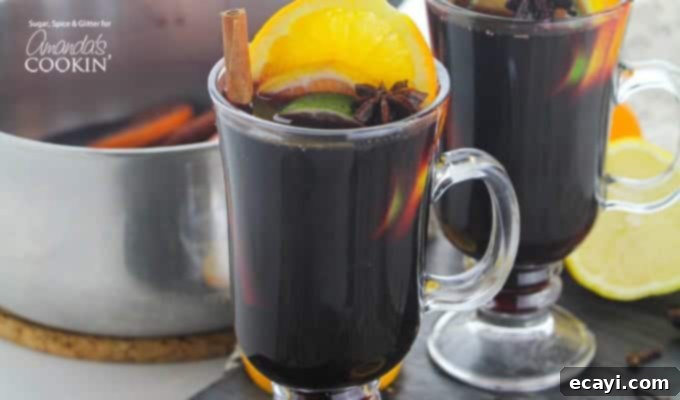
Frequently Asked Questions About Mulled Wine
Here are some common questions about making and enjoying mulled wine, along with helpful answers to ensure your holiday concoction is perfect every time:
Can I make mulled wine ahead of time?
Absolutely! Mulled wine is one of those wonderful beverages that can often taste even better a day or two after it’s made, as the flavors have more time to meld and deepen. You can prepare it entirely in advance and store it in an airtight container in the refrigerator for up to 2-3 days. When you’re ready to serve, simply reheat it gently on the stovetop over low heat. Remember to warm it through until steamy, but be careful not to let it boil, as this can cause the alcohol to evaporate and alter the taste.
How long does mulled wine last?
Properly stored in an airtight container in the refrigerator, mulled wine will typically last for 2-3 days. After this period, while it might still be safe to drink, the vibrant flavors can start to diminish, and the fruit in the mixture might become too soft or develop an off-flavor. For the best taste and quality, it’s recommended to consume it within this timeframe.
What if I don’t want alcohol? Can I make a non-alcoholic version?
Yes, you can easily make a delicious non-alcoholic mulled wine, often referred to as mulled cider or spiced punch! Simply substitute the red wine with a good quality non-alcoholic base such as cranberry juice, grape juice, or even a rich apple cider. Follow the same steps, simmering the juices with the spices and citrus. It’s a fantastic, family-friendly option that captures all the festive aromas and flavors without the alcohol, perfect for guests of all ages!
How do I adjust the sweetness of my mulled wine?
The sweetness of your mulled wine can be adjusted precisely to your preference and the natural sweetness of your chosen wine. Start with the suggested amount of sugar in the recipe. After the spices have infused during the initial simmering and reduction, taste the syrup. You can then add more sugar gradually, a tablespoon at a time, until you reach your desired level of sweetness. Honey or maple syrup can also be used as alternative sweeteners for a different flavor profile.
Can I use ground spices instead of whole spices?
While whole spices are generally preferred for mulled wine because they infuse flavor more slowly and don’t leave a gritty residue in your drink, you can use ground spices in a pinch. If opting for ground spices, use about 1/2 to 1/3 of the amount of whole spices (for example, use 1 teaspoon of ground cinnamon instead of 2 cinnamon sticks). Be aware that ground spices can make the wine appear cloudy, so if presentation is key, you might want to place them in a small muslin bag (spice bag) for easy removal, or strain the mulled wine thoroughly before serving.
This mulled wine recipe is a tried and true classic that your guests will absolutely adore this holiday season. We hope it brings warmth and joy to your gatherings. Do you have any fond memories of enjoying mulled wine with loved ones, perhaps at a festive market or a cozy family dinner?
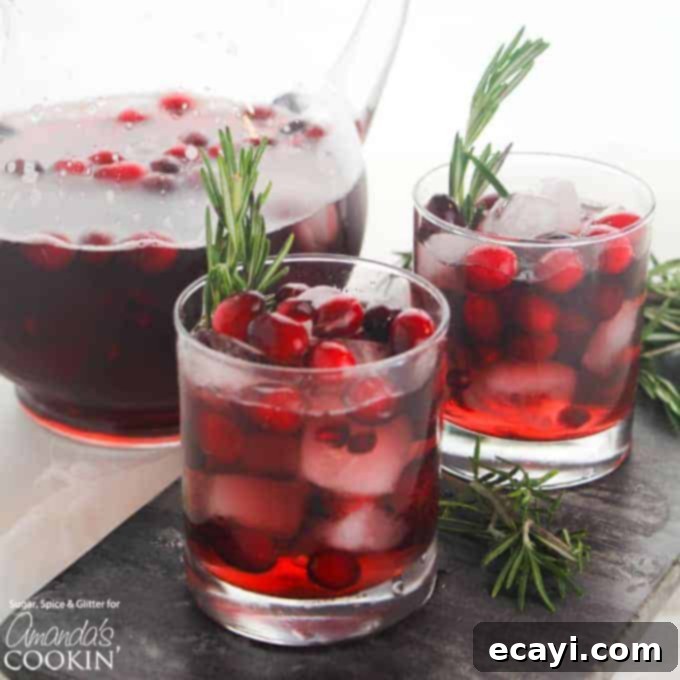
While we’re on the topic of delightful holiday drinks, you won’t want to miss our refreshing Cranberry Holiday Punch. This vibrant, easy-to-make punch is perfect for larger festive parties, whether you’re hosting a warm Thanksgiving feast or a cheerful Christmas gathering!
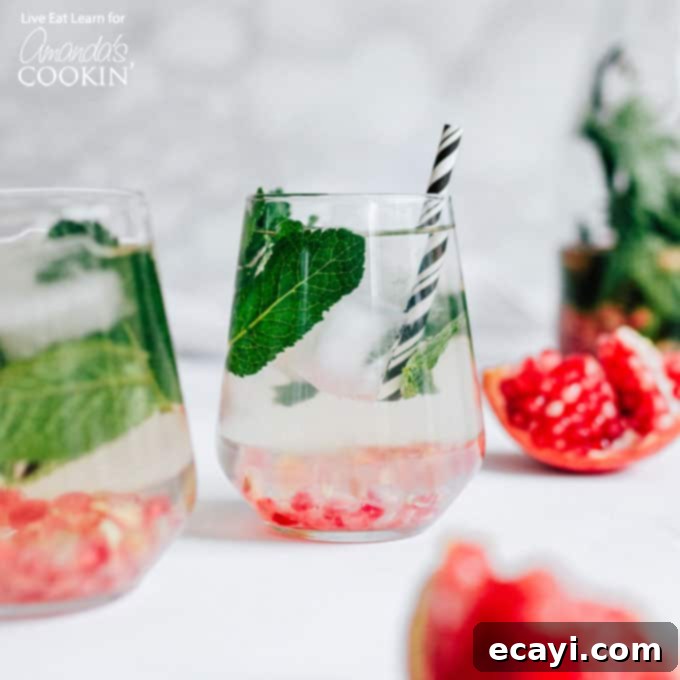
And for a healthy, revitalizing option after the indulgence of the holidays, our Holiday Detox Drink is quick to prepare and incredibly refreshing. With its bright blend of pomegranate and mint, it’s the perfect way to rehydrate and cleanse after those rich holiday meals, helping you feel refreshed and ready for the new year.
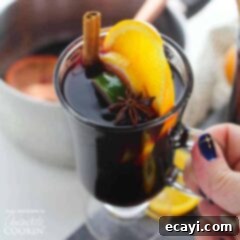
Classic Mulled Wine
IMPORTANT – There are often Frequently Asked Questions within the blog post that you may find helpful. Simply scroll back up to read them!
Print It
Rate It
Save ItSaved!
Ingredients
- 2 cups sugar to taste
- 2 oranges
- 2 clementines
- 1 lemon
- 1 lime
- 8 whole cloves
- 2 cinnamon sticks
- 1 whole nutmeg
- 1 vanilla pod split lengthwise
- 2 star anise pods optional, adjust to taste
- 2 bottles red wine approx. 50 oz / 1.5 liters
Instructions
-
Prepare Your Citrus and Vanilla: Begin by carefully peeling the rinds from your oranges, clementines, lemon, and lime. Try to get as little of the white pith as possible, as it can impart a bitter taste. Once peeled, cut and juice the fruits, reserving both the peels and the fresh juice. Take your vanilla pod and split it lengthwise down the center with a sharp knife to expose the fragrant seeds.
-
Create the Spice Base: In a large saucepan or Dutch oven, combine the sugar, fresh citrus juices, citrus peels, the split vanilla pod, and all your chosen spices (whole cloves, cinnamon sticks, whole nutmeg, and star anise pods if using). Pour in just enough red wine to barely cover the sugar and spices – about 1 to 1.5 cups.

-
Simmer and Reduce: Place the saucepan over medium heat. Bring the mixture to a gentle bubble, stirring occasionally to dissolve the sugar. Once bubbling, reduce the heat slightly and allow the mixture to simmer for about 10-15 minutes, or until the liquid has reduced by half and formed a fragrant, concentrated syrup. This step is crucial for deeply infusing the flavors.
-
Add Remaining Wine and Warm: Turn the heat down to low. Add the remaining bottles of red wine to the saucepan. Gently heat the mulled wine through until it’s steamy and hot, but *do not boil*. Boiling the wine can cause the alcohol to evaporate too quickly and can also alter the delicate balance of flavors, potentially making it taste stewed. Aim for a temperature where it’s pleasantly warm to drink.
-
Serve and Garnish: Once heated, your mulled wine is ready to serve! Ladle it into heat-resistant mugs or glasses. For a beautiful presentation and an extra burst of flavor, garnish each serving with a fresh cinnamon stick, a few thin slices of citrus (orange, lemon, or clementine), and an optional star anise pod. Many people enjoy the spices and fruit remaining in the pot for continued infusion, but you can strain them out if preferred.
-
Enjoy Warm: Mulled wine is traditionally enjoyed warm, providing ultimate comfort on a cold day. While it *can* be served chilled, its comforting nature truly shines when served hot.
Nutrition
The recipes on this blog are tested with a conventional gas oven and gas stovetop. It’s important to note that some ovens, especially as they age, can cook and bake inconsistently. Using an inexpensive oven thermometer can assure you that your oven is truly heating to the proper temperature. If you use a toaster oven or countertop oven, please keep in mind that they may not distribute heat the same as a conventional full sized oven and you may need to adjust your cooking/baking times. In the case of recipes made with a pressure cooker, air fryer, slow cooker, or other appliance, a link to the appliances we use is listed within each respective recipe. For baking recipes where measurements are given by weight, please note that results may not be the same if cups are used instead, and we can’t guarantee success with that method.
